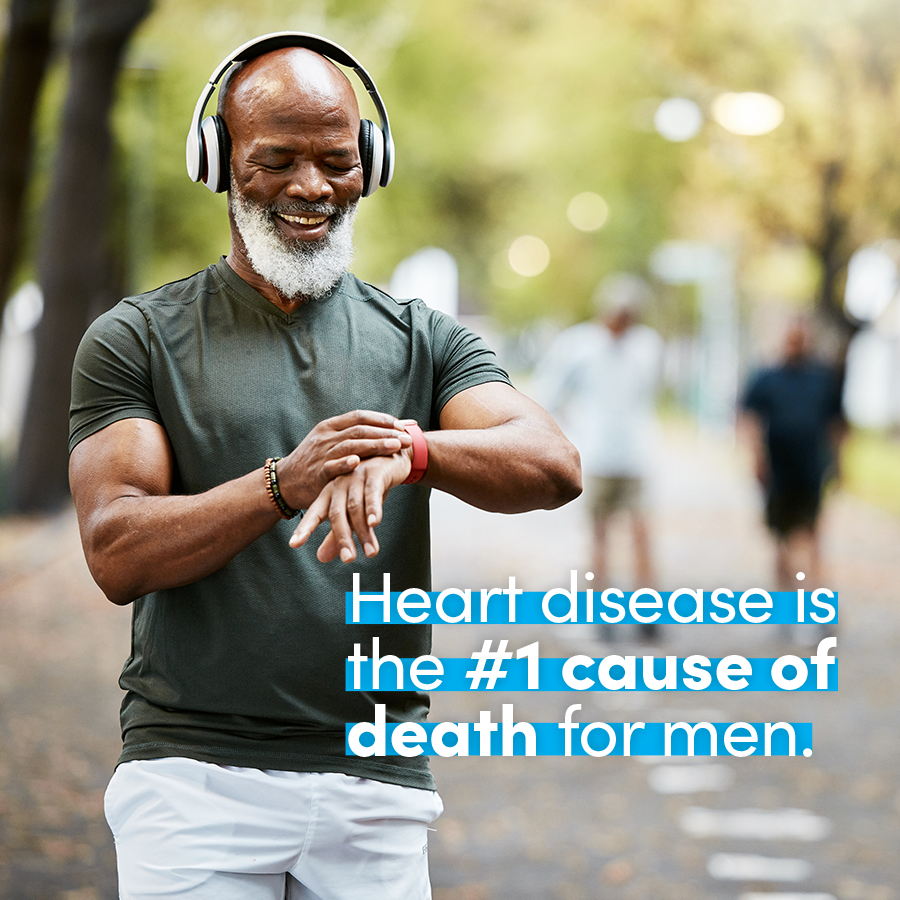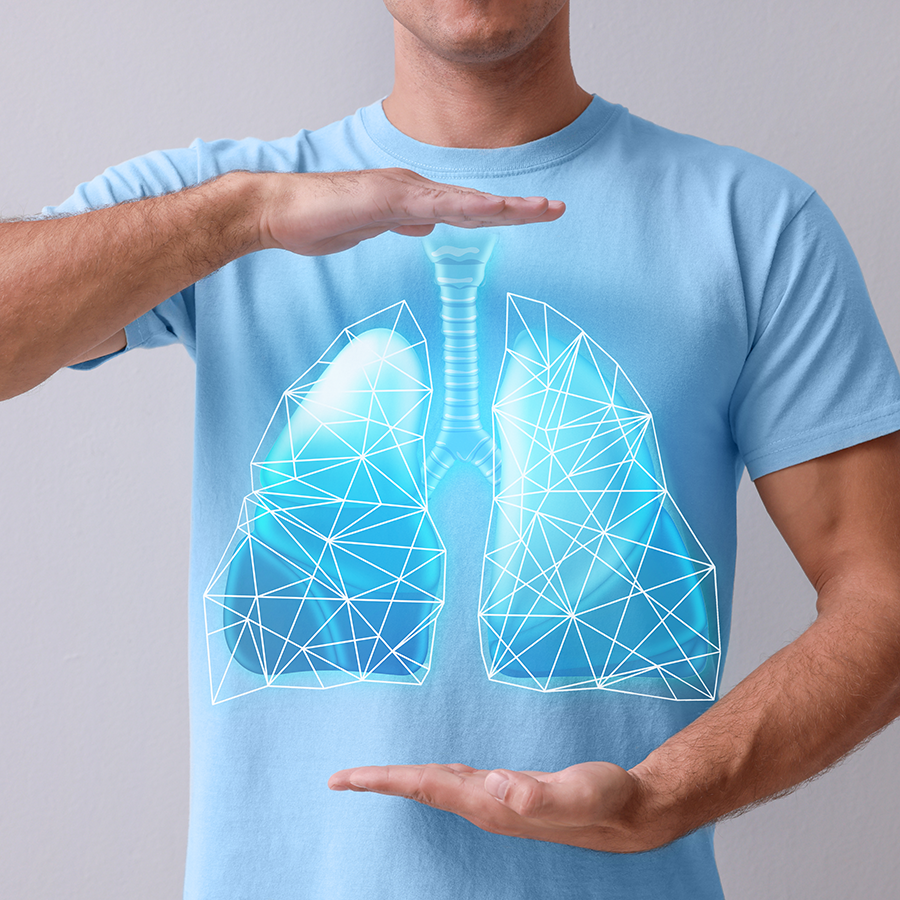A Man’s Guide to Healthy Living – from Heart to Prostate
Healthy living means avoiding the inevitable for as long as possible, so let’s start at the end and work backwards. To understand the keys to better living, we start by examining the statistics about dying.

These are the results for all men in the U.S. across all age groups combined. When we consider men at different stages of life, their risks change:
• Men under the age of 44 are much more likely to die of unintentional injuries than older men.
• The No. 1 cause of death in men 45 to 84 is cancer and the No. 2 cause of death is heart disease. Once men reach 85, those statistics reverse. Men over 85 are more likely to die of heart disease than cancer.
• Suicide is the second leading cause of death in men under the age of 44. When men reach 45, suicide drops to the No. 6 cause of death, and from 65 on it doesn’t even rank in the top 10.
• The No. 10 cause of death for men under 19 is stroke. Between the ages of 20 and 64, stroke moves to the No. 8 cause of death, beginning a slow progression toward the top of the list. For men aged 65 and older, stroke is the fourth leading cause of death.
• Parkinson’s and Alzheimer’s don’t make the top 10 causes of death in men until age 65. Diabetes poses the highest risk of death to men between the ages of 45 and 84.
From these statistics, we can conclude that young men tend to make dangerous choices, men in their middle years need to watch out for disease and that once a man reaches his mid 80s, he’s well on his way to living a long life.
Knowing what you’re up against at any age can help you focus on the areas you need to manage to achieve a long and healthy life.

Avoid Fall Injuries
Unintentional injuries, the fourth-leading cause of death among men of all ages, may result from accidental falls. The National Institute on Aging offers these steps to prevent falling:
• Stay active
• Get enough sleep
• Try balance and strength training exercises
• Fall-proof your home
• Limit alcohol use
• Use a cane or walker when needed
• Stand up slowly
• Choose the right footwear
• Report any falls to your doctor
Testosterone troubles
Testosterone is the hormone that creates the characteristics of masculinity, from facial hair and muscle strength to penis development and sperm production, but it’s not all about sex and reproduction. Throughout a man’s life, testosterone levels can change and affect different systems in the body.
Andropause – what’s that?
Men may begin experiencing a slow decline in their testosterone levels around age 30, a stage of life referred to as andropause. This process is similar to what women experience during menopause, though it manifests differently. Symptoms men may experience sometime after their 30th birthday include:
• Decreased energy
• Trouble focusing
• Difficulty building and maintaining muscle mass
• Erectile disfunction
• Decreased libido
As men progress through andropause, their symptoms may be so gradual that they don’t even notice them at first. Men can also experience night sweats, insomnia and mood swings, like their female peers, but these symptoms tend to be less pronounced and don’t necessarily appear at a set age.
What goes up when testosterone goes down?
Naturally decreasing testosterone levels in men as they age may result in unexpected medical issues.
“Around age 45, that ability to eat three hotdogs and a coke in one sitting and not gain weight is over,” Amanda Gaskin, APRN, points out.
Weight gain is one of the most common health issues she sees in men in her practice. Declining testosterone levels and slowing metabolism can cause men to struggle with weight control and more.
Many men carry that excess weight in the front, around the belly area, which puts pressure on certain blood vessels. Decreased blood flow from weight gain can lead to another common male medical issue, erectile disfunction (ED).
“It’s not necessarily a case of diminished sex drive,” Amanda explains. “The thoughts are there but the body doesn’t show up.”
ED may not be the only consequence of low testosterone weight gain, according to experts at Johns Hopkins. Low testosterone, evidenced by reduced sexual performance, can be a risk factor for heart disease.
That “beer belly” could be doing more than ruining your sex life. It can be an indicator of high blwood sugar and unhealthy cholesterol levels. Taken together, these are all signs you should be checked for heart disease.

Low testosterone and heart disease
While men are generally at risk of heart disease from age 50 on, ED provides one of the few early warning signs. The penis, like the heart, is a vascular organ, but with smaller arteries. According to experts at Johns Hopkins, arterial damage shows up in these smaller arteries months, if not years, before it is evident in the heart. Men who experience ED in their 40s have an elevated risk (up to 80%) of developing heart disease within the next ten years.
The most common forms of heart disease involve restricted flow of blood and oxygen to the heart muscle. A buildup of substances in the arteries referred to as plaque may begin slowly. If undetected and untreated, a complete blockage could occur and result in a heart attack.

Chest pain is the most common sign of heart attack for men, but you can suffer a heart attack without experiencing any chest pain. It is important not to ignore any of these signs and to seek treatment right away.
Prostate: The second heart
The prostate is sometimes referred to as the second heart because of its small heart shape and its important role in the male body. The gland is dependent on testosterone, so as hormone levels change, so does the prostate.
Men have an increased risk of developing an enlarged prostate around age 40. By the time they reach 80, their risk is much greater. An enlarged prostate, also called benign prostatic hyperplasia, can cause annoying symptoms like weak urine stream, difficulty starting the stream, insufficient bladder emptying and waking several times at night to urinate. A urologist should be consulted for treatment options and to monitor possible complications.
Cancer is the most serious prostate issue men face. There may no early warning signs, so annual screenings are important.
“There are new treatment options for prostate cancer where we can avoid radiation and surgery, but we need to detect the cancer early,” notes Dr. Sijo J. Parekattil, medical director at Avant Concierge Urology in Winter Garden.
Is ED pointing in a different direction?
ED can be a warning sign of blood vessel problems that could be caused by diabetes. If diabetes is not controlled by diet and exercise or medical intervention, it can cause damage to blood vessels and nerves. Those small arteries and nerves in the penis can be among the first affected.
Low testosterone levels in men are also linked to an increased risk of diabetes according to the American Diabetes Association. In men with low testosterone, blood sugar spikes and remains high longer after a meal. The pancreas has to work harder to produce insulin to regulate blood sugar. According to Healthline, eventually the pancreas can’t keep up with the amount of insulin needed, which results in diabetes.
Men are not always inclined to discuss changes in their sexual function with anyone, not even a doctor, but ED could be telling them there is a bigger problem.

Gambling may leave you breathless.
Odds are not good for men when it comes to lung disease. Men are more likely to get lung cancer than women and less likely to survive it, according to the American Lung Association. The same is true for pneumonia.
The chances of dying from pneumonia are increased in men because they are less likely than women to seek treatment until symptoms are very severe. A 2019 Cleveland Clinic survey suggests that poor outcomes among men could blamed on their reluctance to seek medical treatment and their propensity to withhold information to avoid dealing with a difficult diagnosis.
Along with lung cancer and pneumonia, men are more susceptible than women to mesothelioma, a rare type of lung cancer linked to asbestos exposure. Men over 65 who were in the military or exposed to asbestos in blue-collar jobs are at the highest risk. Asbestos, declared a carcinogen in 1975, is a very specific pulmonary irritant.
Men exposed to general environmental irritants, smoking and many other factors are more likely than women to develop idiopathic pulmonary fibrosis and scarring of the lungs. IPF is a progressive disease that can be slowed but not reversed. Successful management of IPF relies on early intervention.
Breathe easy knowing that the single common factor in avoiding and surviving these lung diseases is early detection. Talk to your doctor honestly about symptoms you may be having. And don’t wait.
Is being a man part of the challenge?
You may know a man who pushes his physical limits all the time, still running 10 miles a day, pushing through the same workout he did back in college or taking on overtime hours every week at a backbreaking job.
Tammie Stone, MPT, director of physical therapy at Lake Centre for Rehab, notes that men often come in with overuse injuries.
“Aging and other health issues cause a deconditioning they may not be aware of until they sustain an injury doing something they’ve done all their adult lives,” she says.
Sometimes the challenge in men’s health care is treating the overall man.
“I think it is an ego thing,” says Lavonda Goodson, CEO of The Estella Byrd Whitman Community Health Center in Ocala. “Men tend to act like they don’t need a doctor because there cannot be anything wrong with them — just because they are men.”
Treating men in physical therapy can be a challenge, especially among the aging population.
“We have patients at Lake Centre for Rehab who do not want to alter their daily activities despite being in pain,” says Tracey Goldstein-Marquez, DPT.
Men often get stuck in a negative mindset that therapy won’t help, and they just have to live with the pain if they want to continue activities they enjoy.
A man is more likely to talk about his symptoms with a male doctor, especially more intimate issues like rectal bleeding or erectile dysfunction. But for most men, their instinct is to ignore the problem and deal with any resulting discomfort privately.
“As women, I believe our role in men’s health care starts at home. We need to help the men in our lives feel comfortable talking about their symptoms, their aches and pains,” Lavonda explains.
Many women try to step up and do the talking for their man, but this doesn’t solve the problem because the real issue is a man being disconnected from his own body.
Ultimately, men’s health care has to come from men. They have to direct and participate in their own care.
“We have to learn the real support that we offer our loved ones is moving them to the point of being able to speak up when something is wrong,” Lavonda concludes.


